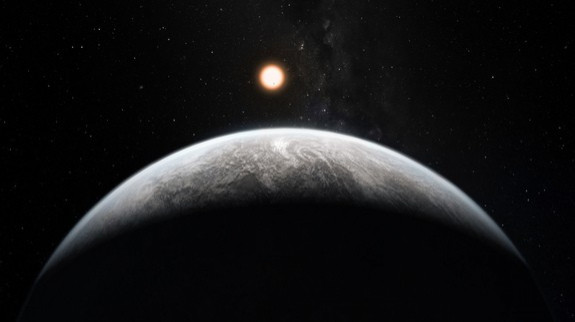Newly Discovered Planet Could Support Life, Astronomers Say

More than 50 new alien planets -- including one super-Earth that could potentially support life -- have been found in the largest extrasolar planet haul announced at one time, astronomers say.
European astronomers announced the discovery Monday along with about 50 other planets outside our solar system at a conference in Moran, Wyo.
The newly discovered planet was found using data from the European observatory's High Accuracy Radial velocity Planet Searcher spectrograph, or HARPS, an instrument on the 11.8-foot telescope at the La Silla Observatory in Chile, ESO officials announced at a news briefing.
The new planet orbits a star about 35 light-years from Earth in the constellation Vela. A team of European astronomers, who discovered it believe there is a small possibility that it occupies the Goldilocks zone, a term used to refer to planets that are neither too hot nor too cold to support liquid water.
A Habitat Comparable to Earth?
If we are really, really lucky, this planet could be a habitat comparable to Earth, said study author Lisa Kaltenegger, an astronomer with the Max Planck Institute in Germany. It's going to be really muggy, just think about the muggiest (Washington) day you can think of. We're not saying it's habitable for you and me.
Water is the key to a planet being able to support Earth-like life, scientists say.
Kaltenegger suggested, however, than other types of life -- probably shorter and squatter life -- could conceivably take root there, The Associated Press reported. They would probably be closer to the ground than humans because gravity on this larger-than-Earth planet is about 1.4 times what we experience, she said.
For it to support life, it would need to be rocky, instead of being gas-based like Jupiter, and would need enough cloud cover from its atmosphere to keep the surface cool. The new planet, called HD85512b, is designated a super-Earth because it is 3.6 times the mass of Earth (super-Earths must be between one and ten times the mass of Earth to qualify). The planet is closer to its star than the Earth is to our sun, completing a full orbit every 60 days, but its star is about 1,800 degrees cooler than our sun.
The abundance of alien planets now stands at more than 600, boosted by Monday's announcement of the 50 new alien worlds. Given the technological advances in the field of exoplanet research, it's possible we could see 1,000 confirmed alien worlds very soon, Wesley Traub, chief scientist of NASA's Exoplanet Exploration Program at the Jet Propulsion Laboratory in Pasadena, Calif., told Space.com.
The next big milestone should be 1,000, Traub said. We are learning that there are so many planets out there, and many stars have multiple planets around them, that it's just a question of time until we get to that 1,000 mark of confirmed planets.
In addition to the potential Goldilocks planet, astronomers deduced the existence of 50 other planets by noticing a slight wobble in stars that indicated an orbiting planet's gravitational pull. Sixteen of those planets appeared to be composed of rocks rather than gas.
We are building up a target list of super-Earths in the habitable zone, said Kaltenegger.
Astronomers discovered the first possible Goldilocks planet in 2007, using the same telescope. They dubbed that object Gliese 581d.
© Copyright IBTimes 2024. All rights reserved.





















